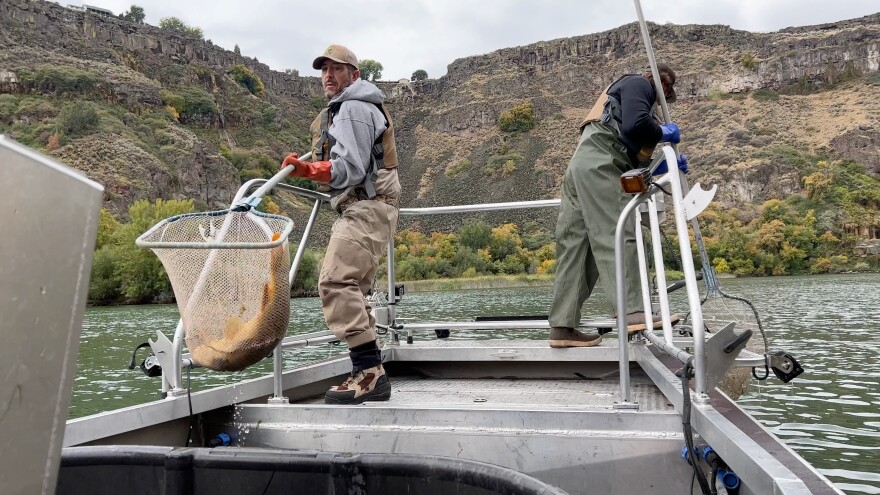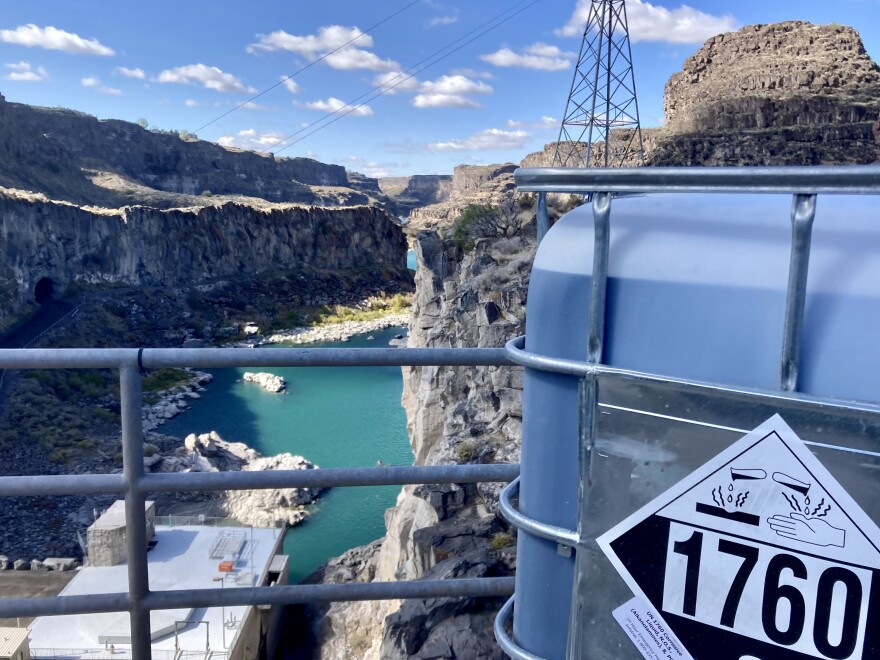State officials gathered on top of the Twin Falls Dam on Wednesday, which is one of the three locations along the Snake River where the Idaho State Department of Agriculture (ISDA) has been deploying a copper-based pesticide to try to eliminate invasive quagga mussels.
The hydroelectric plant operated by Idaho Power is key to the plan. Large tubs of the blue-colored copper chemical Natrix are fed into the intake and the turbines mix it with river water. What emerges at the bottom is a one part per million concentration of the pesticide sufficient to kill mussels.
Over the course of the two-week treatment, which is set to conclude on Friday, about 40,000 gallons of Natrix are expected to be introduced in total.
Though the concentration of Natrix ISDA is maintaining is lower than the drinking water standard, it's still toxic to fish and aquatic plants. In this river stretch there are various fish species, including yellow perch, northern pikeminnow, carp, bass, largescale suckers and white sturgeon.
“Not all fish are dead in there, but the majority likely have been killed," said Idaho Department of Fish and Game Director Jim Fredericks. "That's thousands of fish. It is a large number.”
Most fish that agency staff have found dead are carp, suckers and pikeminnow. However, about 25 of the roughly 50 sturgeon Fish and Game estimated were in this part of the river before the treatment were confirmed dead. The sturgeon were all hatchery-raised.
"That means that while it'll take some time to restore that population, because sturgeon grow slowly, we can restore the population," Fredericks said.
Fish and Game will assess the total damage by comparing electrofishing surveys before and after the treatment.

State officials say the mortality is a price they're willing to pay for the chance that the Snake can return to being free of the extremely invasive and destructive mussels.
"We know that there are difficult parts of this treatment," said ISDA Director Chanel Tewalt. "But, unfortunately, the alternative is worse. Doing nothing is worse than the treatment."
The complexity of the treatment process involved the transportation of heavy chemical containers into deep canyons and maneuvering around waterfalls. Crews had to lower boats into the river by helicopter due to a lack of convenient access below Shoshone Falls.
They also paid extra attention to deep-water pools within the river to ensure that the chemical reached the bottom. Many even camped in the canyon during the treatment to monitor it around-the-clock.
While the hands-on part of the treatment is wrapping up this week, assessing its success may take until next year.
"It's going to be a bit of a long winter, to be honest," Tewalt said.
ISDA staff will continue monitoring for mussel larvae. However, in the coming months, this task could become more challenging as mussels reduce their reproductive activity in colder temperatures. With fewer larvae being released, detecting the mussels might become more difficult, although they could still be alive.
“This winter, hopefully there are no mussels -- they have been completely eradicated, but we will ramp up sampling as weather improves next year," Tewalt said.
Recreation closures are still in effect along the river, but certain sites may reopen once ISDA removes its treatment equipment.
Find reporter Rachel Cohen on Twitter @racheld_cohen
Copyright 2023 Boise State Public Radio



